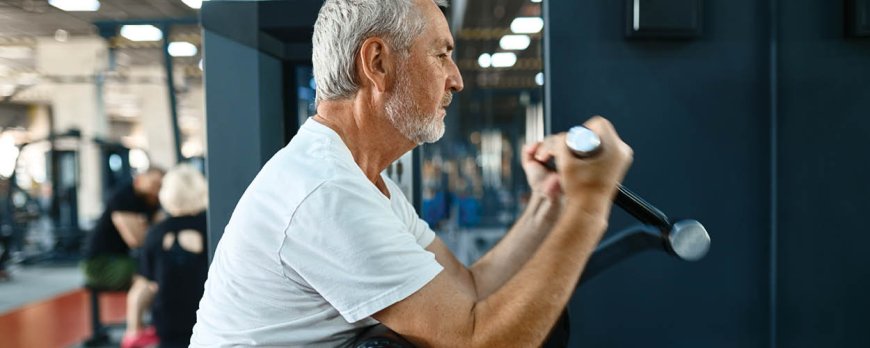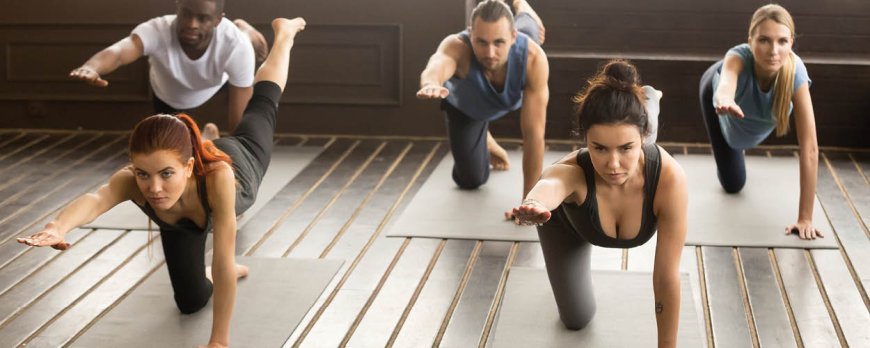How do you tell if you are fit for your age?
Ever wondered, 'How do you tell if you are fit for your age?' Discover tips to gauge your fitness level compared to average fitness standards.

How do you tell if you are fit for your age?
Age plays a significant role in determining an individual's fitness level. As we grow older, it becomes crucial to assess our fitness and gauge whether we are fit for our age. Determining if you are fit for your age requires assessments in various areas such as aerobic fitness, muscular strength and endurance, flexibility, body composition, and mobility.
Key Takeaways:
- Assess your aerobic fitness by measuring your resting heart rate and target heart rate zone.
- Perform tests such as pushups and situps to evaluate your muscular strength and endurance.
- Use the sit-and-reach test to assess your flexibility.
- Measurements such as waist circumference and BMI can help evaluate your body composition.
- Regular exercise and progress monitoring are crucial for maintaining and improving your fitness level.

Assessing Aerobic Fitness Based on Age
One way to determine your fitness level for your age is by assessing your aerobic fitness, which measures your cardiovascular health and endurance. To gauge your aerobic fitness, you can start by measuring your resting heart rate, which is the number of times your heart beats per minute when you are at rest. A lower resting heart rate generally indicates a higher level of cardiovascular fitness. It is best to measure your resting heart rate in the morning before getting out of bed.
To further assess your aerobic fitness, you can calculate your target heart rate zones. These zones indicate the range in which your heart rate should be during different levels of physical activity. For moderate activities, such as brisk walking or cycling, the target heart rate should be between 50-70% of your maximum heart rate. For more vigorous activities like running or high-intensity interval training, the target heart rate zone is between 70-85% of your maximum heart rate.
Another way to evaluate your aerobic fitness is to time yourself on a 1.5-mile run. This test measures your ability to sustain a moderate level of endurance. You can compare your performance to age-based indicators to determine how your fitness level aligns with others in your age group. Remember to warm up properly before attempting any fitness tests and consult with a professional if you have any underlying health conditions.
To summarize, assessing your aerobic fitness is crucial in determining your fitness level for your age. By measuring your resting heart rate, calculating your target heart rate zones, and timing yourself on a 1.5-mile run, you can gain valuable insights into your cardiovascular health and endurance. These assessments, combined with other tests for muscular strength and endurance, flexibility, body composition, and mobility, can help you paint a comprehensive picture of your overall fitness and guide you towards age-appropriate fitness goals.
Evaluating Muscular Strength and Endurance for Age-Specific Fitness
Muscular strength and endurance are vital for overall fitness, particularly as we get older. Evaluating your performance in exercises like pushups and situps can provide insights into your fitness level for your age. These assessments help determine the condition and capabilities of your muscles, which play a crucial role in maintaining functional fitness as we age.
To evaluate your muscular strength, you can perform pushups, which engage various muscle groups in your upper body, including your chest, shoulders, and triceps. Start by assuming a plank position with your hands slightly wider than shoulder-width apart. Lower your body until your chest grazes the floor, and then push back up to the starting position. Count the number of pushups you can complete with proper form and compare your performance to age-based indicators.
Similarly, situps can be used to assess your muscular endurance, specifically in your core muscles. Lie on your back with your knees bent and feet flat on the floor. Cross your arms over your chest or place your hands behind your head. Engage your core and lift your upper body off the ground, bringing your chest towards your knees. Lower yourself back down to the starting position. Count the number of situps you can perform in a minute and compare your performance to age-related benchmarks.
By evaluating your performance in these exercises, you can gauge your muscular strength and endurance and gain a better understanding of your fitness level for your age. Remember, it's important to perform these exercises with proper form to ensure accurate results. If you have any concerns or limitations, it's always recommended to consult with a fitness professional or healthcare provider.

Gauging Flexibility and Mobility as a Measure of Age-Appropriate Fitness
Flexibility and mobility are crucial aspects of fitness that impact daily activities and overall quality of life. Maintaining good flexibility allows you to move freely and comfortably, reducing the risk of injury and enhancing your performance in various physical activities. To determine your fitness level for your age, it is important to gauge your flexibility through specific tests. One such test is the sit-and-reach, which measures the flexibility of your hamstrings and lower back.
The sit-and-reach test involves sitting on the floor with your legs extended in front of you and reaching forward as far as possible. By measuring the distance you can reach or the level achieved on a specific measuring device, you can assess your flexibility and compare it to age-based indicators. This test provides valuable insight into the flexibility of your lower body, which is essential for activities such as bending, reaching, and maintaining balance.
How to Perform the Sit-and-Reach Test:
- Find a flat surface and place a measuring device, such as a sit-and-reach box, in front of you.
- Sit on the floor with your legs extended in front of you, keeping your feet flat against the measuring device.
- Slowly reach forward, sliding your hands along the measuring device while keeping your knees straight.
- Reach as far as possible without bouncing or jerking, holding the furthest point for a few seconds.
- Record the level reached on the measuring device or measure the distance reached.
By incorporating flexibility tests like the sit-and-reach into your fitness assessments, you can gain a better understanding of your age-appropriate fitness level. Remember that flexibility training should be incorporated into your exercise routine to improve and maintain optimal flexibility, allowing you to move with ease and confidence as you age.

Evaluating Body Composition for Age-Specific Fitness
Understanding your body composition is essential in determining your overall fitness level for your age. Assessments like waist circumference and BMI can provide valuable insights into your body's composition and potential areas for improvement.
Measuring your waist circumference is a straightforward way to evaluate body composition. Use a measuring tape and wrap it around your waist at the level of your belly button. A healthy waist circumference for men is generally less than 40 inches, while for women, it is less than 35 inches. If your waist circumference exceeds these guidelines, it may indicate excess abdominal fat, which is associated with an increased risk of certain health conditions.
Body Mass Index (BMI) is another commonly used assessment to evaluate body composition. To calculate your BMI, divide your weight in kilograms by the square of your height in meters. The resulting number can help categorize your body composition as underweight, normal weight, overweight, or obese. However, it is important to note that BMI is a general indicator and may not consider individual variations such as muscle mass. Therefore, it is advisable to consult a fitness professional for a more accurate assessment.
By assessing your body composition, you can gain a better understanding of your physical health and identify areas for improvement. Whether it's reducing abdominal fat, increasing muscle mass, or achieving a healthy weight, focusing on improving body composition can help you achieve age-specific fitness goals and maintain overall well-being.
The Impact of Regular Exercise and Progress Monitoring on Age-Appropriate Fitness
Engaging in regular exercise is a key element in maintaining and improving fitness levels for your age. By monitoring your progress, you can track the effectiveness of your fitness routine and make necessary adjustments. Consistent physical activity not only helps to improve cardiovascular health, but also boosts muscular strength and endurance, enhances flexibility, and promotes overall well-being.
When it comes to regular exercise, it's important to find activities that you enjoy and that align with your fitness goals. Whether it's brisk walking, swimming, cycling, or participating in group fitness classes, the key is to engage in activities that challenge your body and elevate your heart rate. A combination of aerobic exercises, strength training, and flexibility exercises can help you achieve a well-rounded fitness routine.
One effective way to stay motivated and monitor your progress is by setting specific fitness goals. These goals can be short-term or long-term targets that can be measured and evaluated. For example, you could aim to increase the number of pushups or situps you can perform in a set amount of time, or track your running pace to see improvements over time. By regularly assessing and evaluating your progress, you can identify areas of improvement and celebrate your achievements along the way.
- Engage in regular exercise that includes a combination of aerobic, strength, and flexibility exercises
- Set specific fitness goals that can be measured and evaluated
- Monitor your progress by tracking key indicators such as heart rate, running time, or strength test results
- Make necessary adjustments to your fitness routine based on your progress and goals
Remember, fitness is a journey, and it's important to approach it with patience and consistency. By engaging in regular exercise and monitoring your progress, you can maintain an optimal fitness level that is appropriate for your age, leading to improved overall health and well-being.

Other Factors Affecting Fitness Age
While the assessments mentioned earlier provide valuable insights into fitness levels for different age groups, it's essential to consider other factors that can impact fitness age, such as overall muscle strength and power.
Overall muscle strength and power play a significant role in determining an individual's fitness age. As we age, we naturally experience a decline in muscle mass and strength, known as sarcopenia. This can affect our ability to perform daily activities and maintain functional independence.
To combat the effects of sarcopenia and maintain or improve overall muscle strength and power, it's important to incorporate resistance training exercises into our fitness routines. This can include weightlifting, bodyweight exercises, and resistance band workouts. By engaging in regular strength training, we can help preserve muscle mass, increase muscle strength, and improve overall physical performance.
Tips for improving overall muscle strength and power:
- Include resistance training exercises at least two to three times per week.
- Vary your workouts by targeting different muscle groups.
- Gradually increase the weight or resistance as you get stronger.
- Ensure proper form and technique to maximize effectiveness and minimize the risk of injury.
- Listen to your body and allow for adequate rest and recovery between workouts.
By focusing on overall muscle strength and power alongside other assessments mentioned earlier, you can gain a more comprehensive understanding of your fitness age and work towards improving your overall fitness level.
Maintaining an Optimal Fitness Level as You Age
As you age, maintaining an optimal fitness level becomes increasingly important for overall health and well-being. By following a balanced exercise routine that includes strength training, flexibility exercises, and cardiovascular activities, you can enhance your fitness as you grow older.
Strength Training
Strength training is crucial for maintaining muscle mass and bone density, two key factors in preserving mobility and functional independence as you age. Incorporate exercises that target major muscle groups, such as squats, lunges, and push-ups. Aim to perform strength training exercises at least two to three times a week, gradually increasing the resistance or weight as your strength improves.
Flexibility Exercises
Flexibility exercises play a vital role in maintaining joint mobility and preventing muscle stiffness. Include activities like yoga, stretching, and Pilates in your fitness routine. These exercises can improve your range of motion, enhance posture, and reduce the risk of injuries. Remember to warm up before stretching and hold each stretch for 15 to 30 seconds, avoiding bouncing or jerking movements.
Cardiovascular Activities
Engaging in regular cardiovascular activities is crucial for heart health and overall fitness. Aim for at least 150 minutes of moderate-intensity aerobic exercise or 75 minutes of vigorous-intensity exercise per week. Activities such as brisk walking, jogging, swimming, or cycling are excellent choices. Alternatively, you can break down your exercise into shorter sessions throughout the day, based on your preferences and physical abilities.
By incorporating these elements into your fitness routine and customizing it to your abilities and goals, you can maintain an optimal fitness level as you age. Remember to listen to your body, pace yourself, and seek guidance from fitness professionals if needed. Stay committed to your exercise program and enjoy the many benefits of an active and healthy lifestyle.
Consultation with Fitness Professionals for Age-Specific Programs
To optimize your fitness level for your age, consulting with fitness professionals can provide valuable insights and guidance in developing age-specific exercise programs that cater to your unique needs, goals, and limitations. Fitness professionals have the expertise and knowledge to assess your current fitness level and design a personalized program that takes into account your age, physical condition, and any potential health concerns.
A consultation with a fitness professional begins with a comprehensive assessment, which may include evaluations of your aerobic fitness, muscular strength and endurance, flexibility, and body composition. Based on the results of these assessments, the fitness professional will create an exercise program that is tailored to your specific age-related fitness goals.
One of the key advantages of working with a fitness professional is their ability to provide guidance on proper exercise techniques, ensuring that you perform exercises correctly and safely. They can also help you progress gradually, adjusting your program as you improve and setting new goals to keep you motivated.
Benefits of Consulting with Fitness Professionals:
- Access to expert knowledge and guidance
- Personalized exercise programs based on your age and fitness level
- Assistance in setting realistic and achievable goals
- Proper instruction on exercise techniques to prevent injury
- Regular monitoring and adjustments to your program for continued progress
Remember that fitness is a lifelong journey, and working with a fitness professional can help you navigate the challenges and maximize the benefits at every stage of life. Their expertise and support can ensure that your exercise program is not only effective but also enjoyable, helping you stay motivated and committed to maintaining an optimal fitness level as you age.

Incorporating Healthy Lifestyle Choices for Age-Appropriate Fitness
Achieving and maintaining age-appropriate fitness involves more than just exercise. Incorporating healthy lifestyle choices, including proper nutrition, adequate rest, and prioritizing overall well-being, is crucial for optimal fitness as you age.
When it comes to nutrition, fueling your body with the right nutrients is essential for supporting your fitness goals. Aim to consume a balanced diet that includes a variety of fruits, vegetables, whole grains, lean proteins, and healthy fats. Stay hydrated by drinking plenty of water throughout the day, as it helps maintain optimal bodily functions and aids in recovery.
Getting adequate rest is equally important in the pursuit of age-appropriate fitness. Allow your body time to recover and recharge by prioritizing quality sleep. Aim for 7-9 hours of uninterrupted sleep each night. In addition, incorporating regular stress-reducing practices, such as meditation or yoga, can help promote overall well-being and improve sleep quality.
- Focus on proper nutrition, including a balanced diet of fruits, vegetables, whole grains, lean proteins, and healthy fats.
- Stay hydrated by drinking plenty of water throughout the day to support optimal bodily functions and aid in recovery.
- Prioritize quality sleep by aiming for 7-9 hours of uninterrupted sleep each night.
- Incorporate stress-reducing practices like meditation or yoga to promote overall well-being and improve sleep quality.
By adopting these healthy lifestyle choices alongside regular exercise, you can enhance your age-appropriate fitness journey. Remember, fitness is not just a single component but a holistic approach that encompasses various factors. Taking care of your body through proper nutrition, rest, and overall well-being will contribute to maintaining an optimal fitness level as you age.
Conclusion
Determining whether you are fit for your age involves assessing various aspects of fitness, such as aerobic capacity, muscular strength and endurance, flexibility, body composition, and overall mobility. By understanding these assessments and incorporating regular exercise, healthy lifestyle choices, and seeking professional guidance when needed, you can achieve and maintain an age-appropriate fitness level.
To assess your aerobic fitness, you can measure your resting heart rate and target heart rate zone. The target heart rate zone for moderate activities is 50-70% of your maximum heart rate, while for vigorous activities it is 70-85%. Timing yourself on a 1.5-mile run and comparing your time to age-based indicators can also provide insights into your aerobic fitness.
For muscular strength and endurance assessments, tests such as pushups and situps can be performed. Comparing your performance to age-based indicators can help determine if you are at an appropriate fitness level for your age.
Assessing flexibility can be done through the sit-and-reach test, which measures how far you can reach forward while sitting with your legs extended. Lastly, body composition can be assessed through measurements such as waist circumference and body mass index (BMI).
Regular exercise and monitoring your progress are essential for maintaining and improving your fitness level. Additionally, factors like overall muscle strength and power can impact your fitness age. By consistently engaging in physical activity, making healthy choices, and addressing specific needs through professional guidance, you can effectively maintain an optimal fitness level as you age.
FAQ
How do you determine if you are fit for your age?
Assessments in various areas such as aerobic fitness, muscular strength and endurance, flexibility, body composition, and mobility can help determine if you are fit for your age.
How can you assess your aerobic fitness based on your age?
You can measure your resting heart rate and target heart rate zone. The target heart rate zone for moderate activities is 50-70% of your maximum heart rate, while for vigorous activities it is 70-85%. You can also assess your aerobic fitness by timing yourself on a 1.5-mile run and comparing your time to age-based indicators.
How do you evaluate muscular strength and endurance for age-specific fitness?
You can perform tests such as pushups and situps and compare your performance to age-based indicators to evaluate your muscular strength and endurance.
How can you gauge flexibility and mobility as a measure of age-appropriate fitness?
The sit-and-reach test, where you reach forward while sitting with your legs extended, can be used to assess flexibility and mobility.
How do you evaluate body composition for age-specific fitness?
Measurements such as waist circumference and body mass index (BMI) can be used to evaluate body composition for age-specific fitness.
What is the impact of regular exercise and progress monitoring on age-appropriate fitness?
Regular exercise and monitoring your progress can help you maintain and improve your fitness level for your age.
What are the other factors affecting fitness age?
Other factors that can impact fitness age include overall muscle strength and power.
How can you maintain an optimal fitness level as you age?
Maintaining an optimal fitness level as you age can be achieved by adopting a balanced exercise routine, incorporating strength training, and prioritizing flexibility and cardiovascular activities.
Should you consult with fitness professionals for age-specific programs?
Yes, seeking guidance from fitness professionals can help develop age-specific fitness programs tailored to your individual needs, goals, and limitations.
What are the healthy lifestyle choices to incorporate for age-appropriate fitness?
In addition to regular exercise, incorporating healthy lifestyle choices such as nutrition, rest, and overall well-being is important for age-appropriate fitness.


































































































































